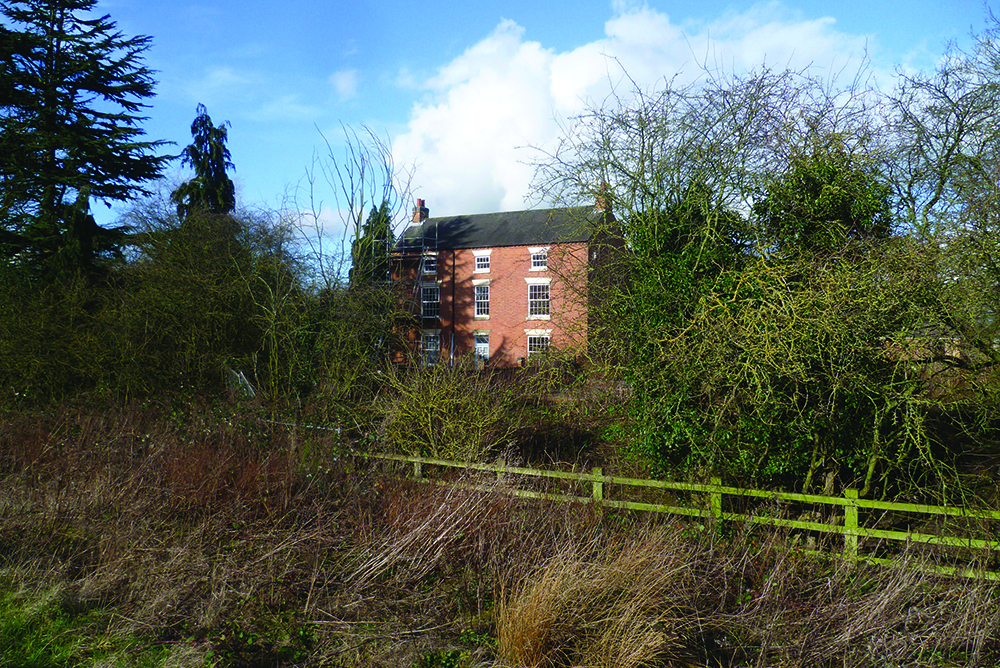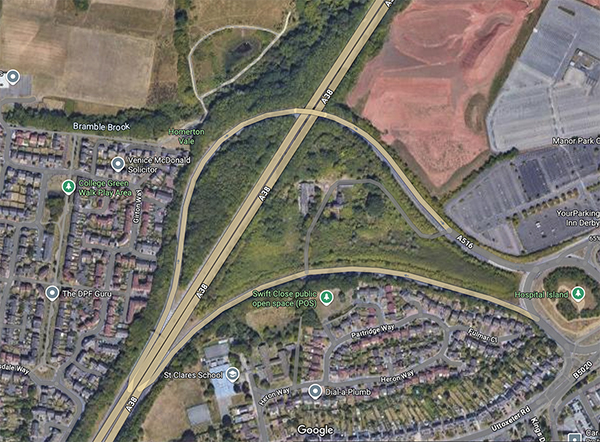Lost Houses of Derbyshire – Rough Heanor Manor

By Maxwell Craven
If you drive from the Royal Derby Hospital to the A38, you might notice that, between the two is an island of overgrown vegetation with a busy slip road on either side of it: a rather desolate place surrounded by roads. Although it is not visible, inside stands an 18th century brick farmhouse and some mainly modern outbuildings: Rough Heanor Farm. It all looks frightfully unprepossessing. Yet in truth the site has a very long history and one not without significance, in the main all well recorded in Medieval charters and post-Medieval estate records.
Originally, its name was simply Heanor (Henovere), part of a suite of three names in Mickleover ending with the modern English suffix ‘-over’: Mickleover, Littleover and Rough Heanor. Heanor is a combination of Saxon heah (= high) and ofer (= ridge), thus ‘High Ridge’. A thousand years ago Rough Heanor was part of the large and important manorial estate of Mickleover, first recorded in Domesday Book, and then also consisting of Mickleover itself, Littleover, Findern and Potlock. For reasons now lost to us, the entire manorial estate was, at some time after 25th December 1066 and 1st January 1085 granted by the King to the Abbot and canons of the Abbey of Burton.
(Rough) Heanor itself is first named in the early 12th century, in a land grant of Geoffrey, Abbot of Burton, confirmed in a charter issued between 1150/1159 by his successor, Robert who ‘…concedes the grant made by my predecessor of blessed memory Geoffrey…to Robert son of Walchelin…that land in [Mickle]over called Heanor’. This Robert son of Walchelin, or ‘FitzWalchelin’, held the land in perpetuity in return for an annual payment of 5/- (25p) – a nominal sum, representing that although the grant was hereditary, the Abbot remained technically feudal overlord of the estate. Abbot Robert’s successor, Bernard, in 1160/74 increased the annual payment of half a mark (thus 6/8d = 34p).

Robert’s father Walchelin held the neighbouring manorial estate of Radbourne. He had married a daughter of Henry de Ferrers, one of the great feudal barons of the Conquest who was by 1086 in possession of 115 manorial estates in Derbyshire alone, including Radbourne. Walchelin’s name suggests that he was already a kinsman of some kind of Henry de Ferrers, too. Robert had three sons, of whom the eldest, Robert III FitzWalchelin became the ancestor of the Chandos and Pole families, the second was settled upon an estate in the NE of Derbyshire, and the youngest, Peter, was settled at Rough Heanor, which was then clearly considered a viable enough estate to support him and his family. This Peter is referred to both as Peter FitzWalchelin and as Peter de Heanor, the latter style clearly implying that he lived on his holding and thus strongly suggests that some kind of a dwelling of élite character must have come into being from this time, the manor house.
Peter’s grandson, Nicholas, seems to have achieved considerable status, for we find him holding the manor of Shipley in 1242 and in 1258 sub-divided portions of the manors of (Rough) Heanor and (Kirk) Langley. The family seem to fade from record after the first third of the 14th century, being most probably wiped out in the Black Death ravaging the country 1348-1350. Subsequently the manor and site of the settlement devolved on the de Heanor’s closest kin, the heirs of Robert III FitzWalchelin of Radbourne and became part of the wider holdings of the Chandos family, by that date the FitzWalchelins’ successors.
There is also plenty of charter evidence for a settlement as part of the manorial estate, too, although it probably ceased to be viable after the Black Death and the ‘climate anomaly’ that immediately preceded it, which plunged the county into cool wet summers and much colder winters after some 600 years of warmth. There was living in (Rough) Heanor in 1327 a Richard ad Crucem – ‘Richard near the Cross’, suggesting a preaching cross was then still extant. It was probably positioned on the border between this part of Mickleover and Littleover, thus on or by the Uttoxeter Road, as a focus of Christian preaching established before the churches came into being.
There is also compelling evidence for the manor house having had a domestic chapel at (Rough) Heanor, too. The fact that this has not been noted previously is that the history of the church of St Mary at the modern town of Heanor has become entangled with references to this chapel at (Rough) Heanor and a lost parish church of St. Mary in Derby. Nevertheless, although not in existence before 1160, the chapel seems to have been founded soon afterwards, probably when Robert FitzWalchelin was granted the estate, as a domestic chapel to the house which Peter FitzWalchelin chose to build there.
This chapel may have been dedicated to St. Nicholas, perhaps explaining the congruence with the name of the two successive Nicholas de Heanors, who seem to have been lords of the manor in the 13th century. One 19th century source indeed, avers that Mickleover church to which the chapel belonged, was once so dedicated itself, probably as a confusion with the chapel-of-ease nearby.
After the late 1340s, then Rough Heanor became a deserted medieval village (DMV) and the house was probably abandoned, or reduced to act as a farm for a Radbourne estate tenant. Yet documents dating to 1398, 1408-1409 and 1492 mention only a leased messuage (house and land), at one stage successively the residence of younger sons, Thomas and John de la Pole, second and third sons of Sir Peter de la Pole, the man who had acquired Radbourne by marriage with the heiress of Sir John Chandos KG, hero of the Hundred Years’ War. In 1713 William Woolley recorded that ‘In 41 Elizabeth [1597] Germain Pole had an estate here…which he left to his son Thomas. I suppose they may have it still and it is now called Rough Heanor.’
This is the first mention of the name with the prefix ‘Rough.’ That a field nearby was called Bowling Alley Field suggests that the tenants perhaps still enjoyed superior status.
In 1767 it was still called Rough Heanor House, rather than ‘farm’ but this must have been cleared away and replaced by the present-long empty and decaying farm house in the 1780s. In 1817 the farmer worked between 150 and 200 acres.


